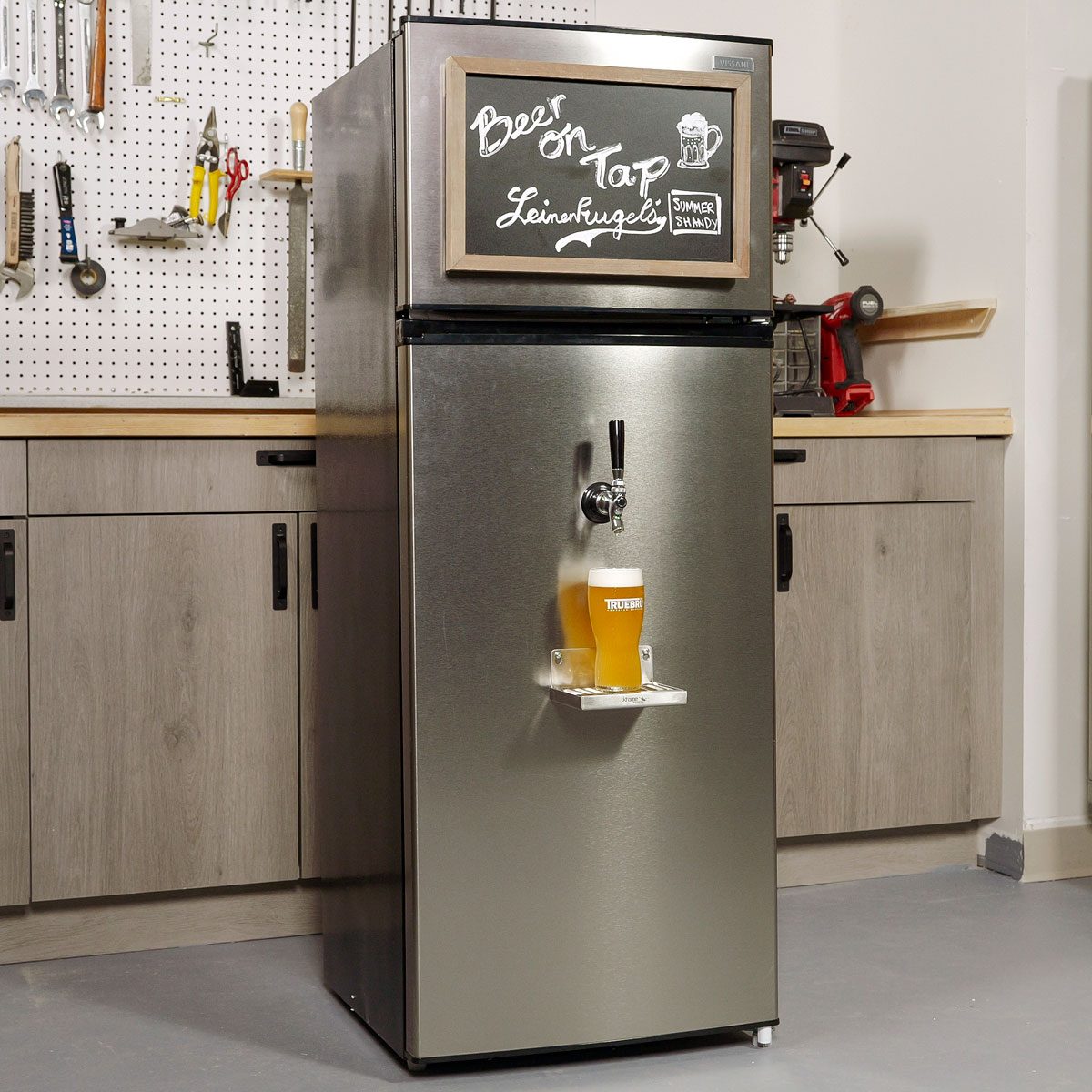From drilling the perfect tap hole to setting the ideal temperature, we'll show you everything you need to know about how to make a kegerator.
1 to 3 hours
Intermediate
$100 to $300
Introduction
Breathe new life into that old fridge by transforming it into a diy kegerator, the perfect addition to any hangout spot.
Looking for a simple way to serve plenty of fresh cold, top-notch beer or root beer? Well, how about building a DIY kegerator? A kegerator is a refrigerator designed to hold and dispense kegs. It keeps the kegs cold and includes a system that allows for easy pouring. This system uses carbon dioxide (CO2) to help push the beer from the keg into your glass. Having a kegerator comes with a bunch of perks. For one, it’s way cheaper than constantly buying packs of aluminum cans or bottles. Plus, kegs keep your beverages fresh for a lot longer. They’re also better for the environment and super convenient.
You will need a refrigerator, DIY kegerator conversion kit, 5lb. CO2 tank and a keg.
I suggest finding a used, reliable refrigerator. Some good places to look are Craigslist, Facebook marketplace, and used appliance stores. The refrigerator I found was from a used outlet store and was slightly scratched, so I got it for a great price. It came with a freezer on top, which is very convenient for storing chilled mugs.
I found a DIY kegerator conversion kit online, but all the parts you will need can also be found at most local brewing supplies stores. The kit comes with a faucet handle, faucet head, shank, hex nut assembly, black rubber washer, beer line, keg (Sankey) coupler, air line, and a double-gauge CO2 regulator.
A full five-pound tank of food-grade CO2 is also required. In my area, Truebrü Homebrew can provide full and empty CO2 tanks, but if you cannot find such a place nearby, try contacting a distributor of industrial and medical gases.

Tools Required
- 7/8” bi-metal hole saw
- Adjustable wrench
- Assorted drill bits
- Drill
- Flathead screwdriver
- Level
- Spanner wrench
- Tape measure
Materials Required
- 1/6-barrel keg
- 10 x 7/8” sheet metal screws
- 5lb CO2 tank
- Eye protection
- Hose clamps
- Kegerator conversion kit
- Marker
- Metal drip tray
- Painter's tape
- Refrigerator
- Soapy water spray bottle
- TPFE (teflon) tape
Project step-by-step (13)
Remove the shelves
Remove shelves from the inside of the refrigerator and set them aside in a safe place.

Take measurements
Before measuring the refrigerator’s interior, a decision must be made: should the CO2 tank be located inside or outside your DIY kegerator?
When the CO2 tank is located outside the refrigerator, you have more space inside for larger kegs or multiple small kegs if you desire to install multiple taps. It also makes it easier to change the CO2 tanks. However, keeping them outside has some disadvantages, such as having to drill another hole in your refrigerator (in addition to the one for the tap) and not being as aesthetically pleasing as keeping everything in one unit.
This kegerator was going to be built with the CO2 tank housed inside the refrigerator. Having said that, it is important to measure the inside of the refrigerator and all the components to ensure that you will be able to fit the CO2 tank, the keg, the CO2 regulator, the keg coupler, the beer lines and the air lines all inside the fridge.

Determine the faucet location
On the inside of the refrigerator door, check the shelves and their location. You will want to choose a location to install the faucet that will provide enough space for the shank to go through the door without hitting a shelf. The other thing you want to keep in mind is that if you have a freezer door on top, you will want clearance so the tap handle does not get bumped every time you open the freezer.
With a tape measure, determine the precise location where you want your faucet head to go. Then, place the painter’s tape in that area before marking it. The painter’s tape will keep the material from chipping as you drill through it.
I decided to place mine in the center of the refrigerator, 10-in. down from the top of the door and centered side to side. I chose this location because I plan to install a longer faucet handle in the future, and I want to ensure it won’t interfere with opening the freezer door.

Drill a hole through the door
Pre-drill with an 11/64-in. drill bit, then drill a 7/8-in. hole through the front of the refrigerator door using a bi-metal hole saw. Drill completely through the metal and plastic to have a nice, clean hole for the shank to fit through. Clean out the hole to avoid any debris going into the shank.

Attach the faucet
Assemble the faucet by hand-tightening the faucet head to the shank. Then, use an adjustable spanner wrench to tighten it further. Attach the faucet handle to the faucet head by turning it clockwise until it is secure.
Place the black plastic flange around the faucet shank and insert the shank of the assembled faucet into the 7/8-in. hole in the door. On the inside of the door, tighten the shank with the flanged lock nut using a wrench until it is secure but not so tight that it compresses the door panel.

Install a drip tray
Measure and mark the location of the drip tray to be centered about 10 inches below the faucet spout. Pre-drill pilot holes and use 7/8-in. sheet metal screws to secure it level on the door.

Connect the beer line
Insert the black rubber washers into the hex nuts located on both ends of the beer line. Attach one end of the beer line to the faucet shank and the other end to the top of the keg coupler. Hand-tighten these first, then use an adjustable wrench to compress the washer slightly and make the connection liquid-tight.

Connect the air line
Connect one end of the air line to the nipple on the side of the keg coupler. Use a hose clamp and a flathead screwdriver to secure the air line tightly to the keg coupler.
Take the opposite end of the air line and slide it over the nipple of the CO2 regulator. Again, use a hose clamp and a flathead screwdriver to secure the air line in place.

Connect the regulator to the CO2 tank
Wrap PTFE tape (aka Teflon tape) clockwise around the valves on the CO2 tank. Tighten the CO2 regulator nut onto the CO2 tank valve outlet by hand, then use a wrench to finish tightening it.

Set the CO2 tank pressure
With the tap handle and regulator shut-off valve closed, open the valve located on top of the CO2 tank to its fully open position. Take note of the PSI dial. The CO2 pressure should be between 10 and 14 PSI. In order to achieve this, adjust the regulator adjustment knob in the middle until the gauge displays a pressure reading within that range. You may need a screwdriver to adjust the pressure adjustment knob, depending on your regulator.
Then, open the regulator shut-off valve by turning it into the vertical position. This will ensure that beer doesn’t flow back into the air line when tapping the keg.
Check for leaks by spraying the connections with soapy water. If bubbles appear, it indicates a leak, requiring better sealing.

Attach the keg
Remove the keg dust cover. Ensure the keg coupler handle is set to the off position so the handle faces upwards and is not depressed. Secure the keg coupler into the keg by pushing the tap into the barrel fitting and turning it clockwise until you cannot turn it any further. Then, pull the handle out and push it down toward the floor until it locks in place.

Test pour
You can run a test pour into a glass by pulling the faucet handle down quickly and fully opening it to minimize excessive foam. If there is excessive foam, double-check that the PSI on the pressure gauge is within the correct range.
Tip: To avoid excessive foam, it’s recommended that the keg settle undisturbed in your DIY kegerator for a few hours before being used. This is also a good time to adjust the refrigerator’s temperature to ensure that you are storing your kegs between 36 and 40 degrees F.

FAQ
How long does beer stay fresh in a kegerator?
Between three and six months. If your beer has been pasteurized, it should stay fresh for at least three months and possibly up to six months if you keep it at the right temperature.
What is the difference between a Keezer and a kegerator?
A kegerator is a modified refrigerator designed to store and dispense kegs, featuring a draft system for easy pouring. A keezer, on the other hand, is a freezer converted for the same purpose.

















